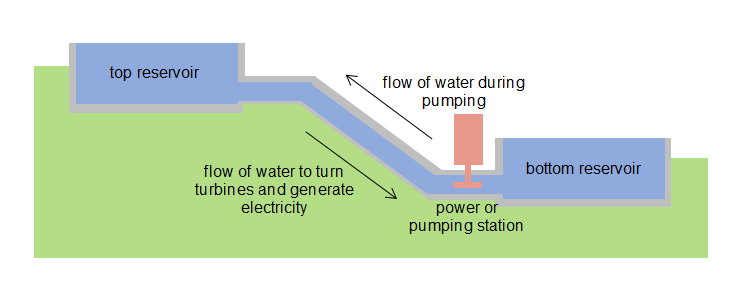Renewable energy generation does not always meet demand. This is because consumers may wish to use energy when the sun isn’t shining or the wind isn’t blowing. Hydroelectric storage can be used to balance this generation and demand problem.
Hydroelectric storage facilities operate like giant batteries. They can store energy when it is available, and later release it on demand. To store energy, hydroelectric storage facilities pump water uphill through pipes from a lower reservoir to a higher reservoir. To generate electricity, water is released from the higher reservoir and falls downhill through pipelines to the lower reservoir. As the water falls it passes through turbines which it spins. More energy is consumed in pumping water than is generated by the water spinning turbines. Generally, hydroelectric storage facilities recover 70% - 80% of energy input.
In a closed system water can be recycled and used over and over again. Reservoirs are often created by damming rivers. They can also by created by flooding mine shafts or other underground cavities. Both kinds of reservoir have their own environmental consequences.
Like batteries, hydroelectric storage facilities assist with a vast range of grid applications including back-up services, generating synthetic inertia and converting non-synchronous power to synchronous power. These are all services that are essential for the reliable operation of an electricity grid.
Further, the National Energy Market operates such that when energy supply is high and demand is low, energy is less expensive. Conversely, when energy demand is high and supply is low, energy is more expensive. Hydroelectric storage facilities can take advantage of this by buying electricity when it is less expensive and selling it when it is more expensive.
The Snowy Hyrdro company advertises that Snowy 2.0 will provide 175 hours of storage to the National Electricity Market. The Snowy Hydro Scheme has 16 major dams, 9 power or pumping stations and 225 kilometres of pipelines. The water of the Snowy, Eucumbene and Murrumbidgee Rivers is captured at high elevations and falls 800m through pipelines to the Murray and Murrumbidgee Rivers at lower elevations.

Diagram of hydroelectric storage facility.
For more information or discussion, please contact Partner, Jonathan Fulcher or Law Graduate, Kate Thorogood from HopgoodGanim Lawyers’ Resources and Energy team.